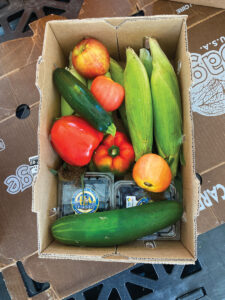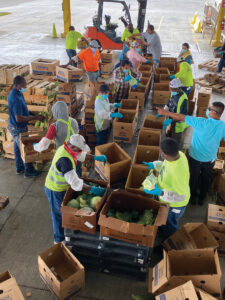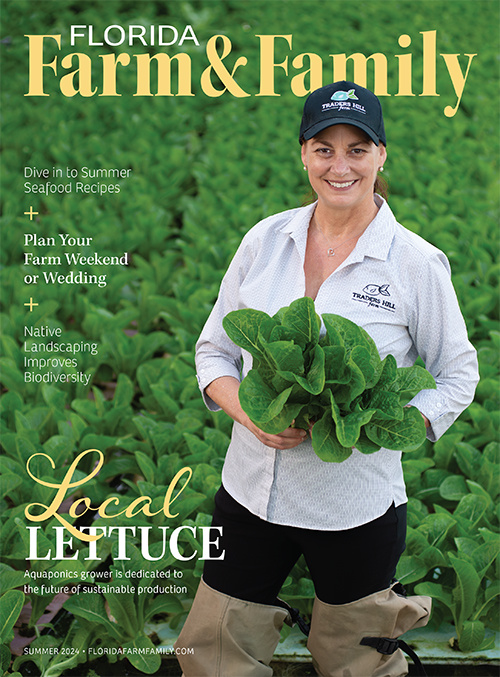
In ordinary times, the complex systems that keep millions of Floridians fed are seemingly invisible. It takes a major economic shake-up to show just how essential every step in the process is.
When coronavirus-related shutdowns began to affect the citizens of Florida, many local farmers were experiencing the peak of their harvest.
“Our harvest season is usually from December to the middle or end of April,” says Stephen Basore, director of food safety at TKM Bengard Farms. “With farming, you start spending money early at planting and you get your income later on during the harvest. The break-even point is somewhere toward the end of our season. Unfortunately, business just dropped off at the tail end of our deal.”
With conventions, tourism and restaurants all suddenly not placing orders, the planned destinations for much of Florida’s produce dried up. Feeding Florida and its network of 12 Florida food banks went to work immediately to attempt to reroute this food through produce-recovery programs.

Springing Into Action
“Within days, we asked our growers if they wanted to create direct-to-consumer-style boxes for food banks,” says Sherri Atwell, director of produce recovery at Feeding Florida. “They could get the food that was in excess off the ground, use their own packing systems, and keep their staff working and food still moving.”
The challenges were multifaceted: Many people were plunged into unemployment, and children were sent home from school, leaving more people at risk of hunger. At the same time, large commercial farms feared that the loss of the most crucial harvest and sales weeks of the season could be financially ruinous. Besides farmers, there are also hundreds of people whose day-to-day employment is tied to the harvest and distribution of Florida-grown produce. The Feeding Florida team formed a bridge to help rescue both farms in trouble and feed thousands of at-risk families.
“In those early weeks, we raised about $1.3 million above our budget to pay harvest costs of about 35 cents per pound to growers,” says Robin Safley, executive director of produce recovery at Feeding Florida. “We were able to help save around 75 jobs across multiple growers in Florida.”
The money raised for the Farmers Feeding Florida program helped farmers to combine their products into Community Supported Agriculture-style (CSA) produce boxes for widespread distribution to the hungry. They found their way into the hands of children who would typically be eating breakfast and lunch at school.
See more: Focus on Heart-Healthy Florida Foods During American Heart Month
Powerful Partnerships
TKM Bengard Farms also started similar outreach programs. “We worked with the Palm Beach County school district where we supplied fresh fruits and vegetables,” Basore says. “We also partnered with the Palm Beach Civic Association, which raised money to buy produce from local farmers and take it to the Palm Beach County Food Bank.”
TKM Bengard Farms, a major producer of iceberg and romaine lettuce, sought out opportunities to collaborate with other farmers to create both for-profit boxes and some at a lower cost or for donation whenever possible.
“I’m not a produce broker – I’m usually focused on food safety – but other farms started purchasing produce from us to create boxes early on,” Basore says. “We weren’t the first people to think of it, but we were able to jump in, sourcing products from other farmers. It’s taken this crisis to bring growers together this way.”

boxes of fresh produce. Credit: Michael Johnson
Tireless farmers, produce-recovery advocates and food-bank workers made a major difference this spring.
“Our no-touch food-box program through the food banks put farmers in a good position to apply for the USDA’s Coronavirus Food Assistance Program, which had very similar food boxes,” Safley says. “Between March 7 and June 15, we moved 17.7 million pounds of produce. The April numbers alone were 2.2 million pounds more than in April of last year.”
Since the pandemic is not likely to abate before the next growing season, the farmers and advocates are already gearing up for what comes next.
“People are realizing just how much we need farmers. We’re in the category with other first responders, people who keep the community safe, because people see how important the food supply is,” Basore says. “We’re just trying to help as many people as we can.”
See More
To learn more about Florida food banks’ efforts and how to donate, visit feedingflorida.org.








